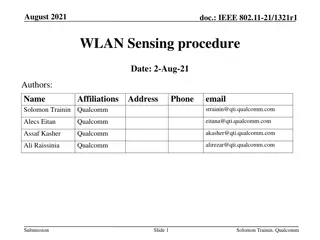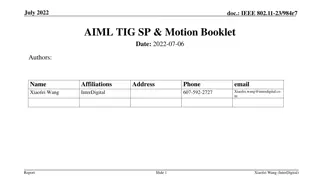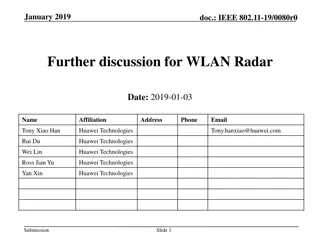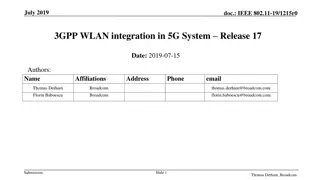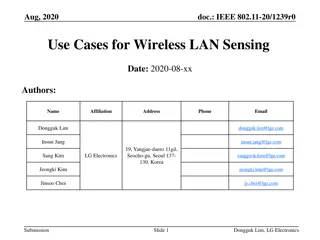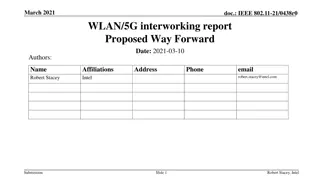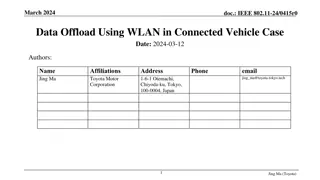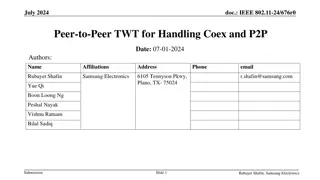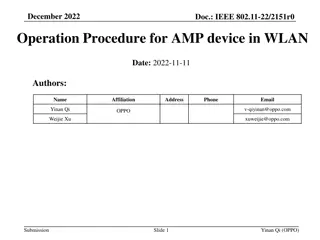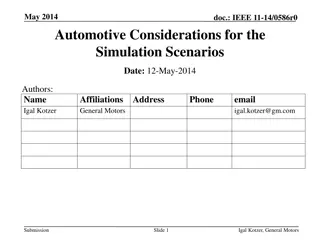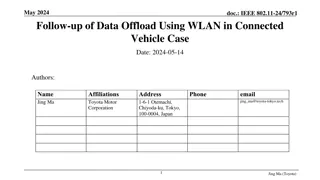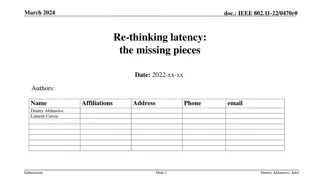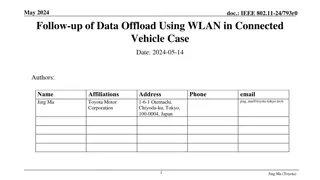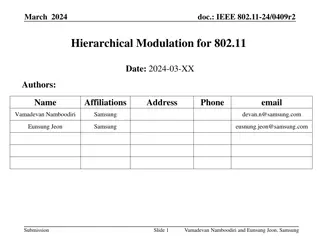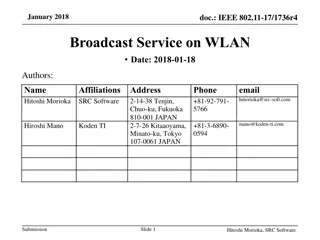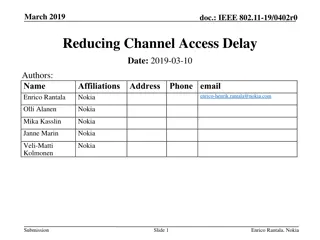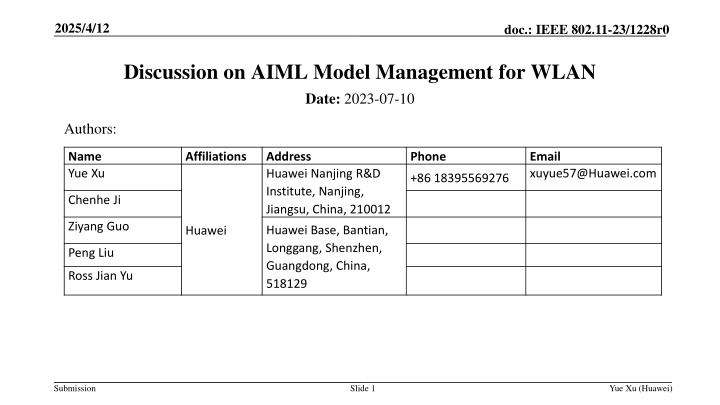
Discussion on AIML Model Management for WLAN
Explore the importance of AIML model management for WLAN, covering topics such as model sharing, selection, and activation in the context of IEEE 802.11 standards and 3GPP processes.
Download Presentation

Please find below an Image/Link to download the presentation.
The content on the website is provided AS IS for your information and personal use only. It may not be sold, licensed, or shared on other websites without obtaining consent from the author. If you encounter any issues during the download, it is possible that the publisher has removed the file from their server.
You are allowed to download the files provided on this website for personal or commercial use, subject to the condition that they are used lawfully. All files are the property of their respective owners.
The content on the website is provided AS IS for your information and personal use only. It may not be sold, licensed, or shared on other websites without obtaining consent from the author.
E N D
Presentation Transcript
2025/4/12 doc.: IEEE 802.11-23/1228r0 Discussion on AIML Model Management for WLAN Date: 2023-07-10 Authors: Name Yue Xu Affiliations Address Huawei Nanjing R&D Institute, Nanjing, Jiangsu, China, 210012 Phone Email xuyue57@Huawei.com +86 18395569276 Chenhe Ji Ziyang Guo Huawei Base, Bantian, Longgang, Shenzhen, Guangdong, China, 518129 Huawei Peng Liu Ross Jian Yu Submission Slide 1 Yue Xu (Huawei)
2025/4/12 doc.: IEEE 802.11-23/1228r0 Introduction AIML models are core and symbolic components within AI systems. In AIML TIG, the model has been mentioned in several use cases [1-4], such as CSI compression, channel access, Multi-AP and model sharing. Efficient model sharing has been included in Technical Report [1]. Besides model sharing, AIML model management (e.g., activation/deactivation/selection/registration/configuration/monitoring) is also an essential topic when implementing AIML, which has been well discussed in 3GPP but less discussed in the TIG. In this contribution, we discuss AIML model management for WLAN and possible standard impacts. Submission Slide 2 Yue Xu (Huawei)
2025/4/12 doc.: IEEE 802.11-23/1228r0 Scenarios of AIML Model Management (1/2) AIML model is lack of explanation and generalization. When a training environment is not similar to a testing environment, the model is ineffective. It may be required that an WNM abnormal event report is added to the model. AIML model sharing will use spectrum resources to reduce the overhead. Several aspects can be considered[4] trigger time, when and what event to trigger model sharing transmission duration, limit the duration of the frame containing the model parameters access category/priority for model sharing frame Roaming may need model selection/switching, e.g., for the CSI compression use case, a well-trained encoder in current AP may not adapt to another target AP. Submission Slide 3 Yue Xu (Huawei)
2025/4/12 doc.: IEEE 802.11-23/1228r0 Scenarios of AIML Model Management (2/2) Controlled decision is important when deploying AI in real-world WLAN use cases. It may need to define standard rules to filter out abnormal actions. The update/diversity of device hardware platforms may need new service and functionality to match the AIML model and hardware platform When a new model is applied, it may need a new procedure to evaluate and test the model A device with a low battery or low computational resource may need an AIML activation/deactivation function Submission Slide 4 Yue Xu (Huawei)
2025/4/12 doc.: IEEE 802.11-23/1228r0 Model Management in 3GPP (1/2) In 3GPP, AIML Model Management is associated with all processes in a life-cycle[6-13], including: Data collection Model registration Model configuration Model selection AIML Model monitoring Model Management Model activation/deactivation Model training Model inference operation Model switching The underline will be introduced the next slide. Model transfer (similar to Model sharing in the TIG) Submission Slide 5 Yue Xu (Huawei)
2025/4/12 doc.: IEEE 802.11-23/1228r0 Model Management in 3GPP (2/2) Type Briefs Model registration Assignment of an identification for an AIML model by the network The identification can be used to identify a model for its life-cycle management Model configuration Configures a model or a set of models per feature, such as input/outputs, pre/post-processing, etc. Model monitoring Monitoring and switching models, based on accuracy and relevance, overhead, complexity, and latency. Model selection For one feature, model selection base on different wireless environment such as channel type, number of active users, indoor/outdoor, moving speed, etc. Make appropriate selection when the model drifts, such as data or performance metrics [5]. Model transfer Delivery of an AIML model over the air interface, together with the parameters of a model structure The aspects of the model transfer mechanism, either using a dedicated frame or payload The model representation format (e.g. defined by external standards or be proprietary including model delivery as a run-time binary image). Submission Slide 6 Yue Xu (Huawei)
2025/4/12 doc.: IEEE 802.11-23/1228r0 Aspects of AIML Model standardization for WLAN Define rules to filter out abnormal decisions Create new service/functionality in WNM , e.g., abnormal event report Create new access category and transmission rules for model sharing to reduce the radio resource overhead Model registration/identification, especially for the enterprise WLAN with central management entity Signaling for AIML model and device hardware platform matching AIML model Activation/deactivation according to device status or type Submission Slide 7 Yue Xu (Huawei)
2025/4/12 doc.: IEEE 802.11-23/1228r0 Summary In this submission, we discuss the scenarios of AIML Model Management, introduce related work in 3GPP and summarize some possible standard impacts for WLAN. Submission Slide 8 Yue Xu (Huawei)
2025/4/12 doc.: IEEE 802.11-23/1228r0 References [1] 11-22/0987r7-aiml-technical-report-draft [2] 11-22-1948-00-aiml-aiml-model-sharing-use-case [3] 11-23-0397-01-aiml-technical-feasibility-analysis-of-ml-model-sharing [4] 11-23-0750-00-aiml-discussions-on-neural-network-model-sharing-for-WLAN [5] Manias D M, Chouman A, Shami A. Model Drift in Dynamic Networks[J]. IEEE Communications Magazine, 2023. [6] R1-2212107, General Aspects of AI/ML Framework , Qualcomm, 3GPP TSG-RAN WG1 #111 [7] R1-2212035, General aspects of AI ML framework and evaluation methodology , Samsung, 3GPP TSG-RAN WG1 #111 [8] R1-2212225, Discussion on general aspects of AI/ML LCM , MediaTek, 3GPP TSG-RAN WG1 #111 [9] R1-2211804, Discussion on general aspect of AI/ML framework , Apple, 3GPP TSG-RAN WG1 #111 [10] R1-2211729, Discussion on general aspects of AI ML framework , InterDigital, 3GPP TSG-RAN WG1 #111 [11] R1-2210884, Discussion on general aspects of AI/ML framework , Huawei, 3GPP TSG-RAN WG1 #111 [12] R1-2211392, Discussion on general aspects of AI/ML framework , Intel Corporation, 3GPP TSG-RAN WG1 #111 [13] R1-2211287, Discussion on general aspects of AI/ML framework , Ericsson, 3GPP TSG-RAN WG1 #111 Submission Slide 9 Yue Xu (Huawei)


